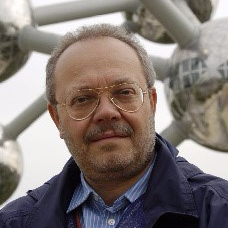Recent Advances in Phosphorus Chemistry
A special issue of Molecules (ISSN 1420-3049). This special issue belongs to the section "Inorganic Chemistry".
Deadline for manuscript submissions: closed (31 March 2022) | Viewed by 14503
Special Issue Editors
Interests: activation and functionalization of elemental phosphorus; activation of small inorganic and organic molecules; transition-metal hydrides and molecular hydrogen chemistry; materials for H-storage; carbon dioxide capture and valorization
Special Issues, Collections and Topics in MDPI journals
Interests: inorganic phosphorus chemistry; homogeneous and heterogeneous catalysis with P-based compounds; metal phosphides and nanoparticles; chemistry of phosphorene
Interests: P-ligands and complexes of transition metals with phosphines; inorganic phosphorus chemistry; organometallic polymers; homogeneous and heterogeneous catalysis; chemistry of phosphorene
Interests: phosphorus chemistry; materials chemistry; functionalization of elemental phosphorus; heterogeneous catalysis; metal nanoparticles
Special Issue Information
Dear Colleagues,
Phosphorus, the multifaceted element, is still attracting the interest of worldwide scientists and specialists from chemical industries.
This Special Issue will collect some of the most recent advances in the fascinating field of phosphorus chemistry, going from molecular science to materials and their wide applications in science and technology. It aims at focusing on the synthesis, characterization, reactivity, and applications of molecular P-based compounds in the field of inorganic, organic, and biological chemistry. Indeed, P-compounds can behave as potential ligands toward transition metals, building blocks for innovative materials and bioactive molecules with applications in life science. Understanding the reaction mechanisms will also be a target of this Special Issue. Finally, a particular focus will be given to P-based materials, including phosphides and two-dimensional materials, i.e., phosphorene, endowed with peculiar physical and chemical properties.
We invite scientists active in these broad areas of chemistry to contribute to this Special Issue with original research articles and reviews on a number of pertinent topics, including, but not limited to:
- Activation and functionalization of elemental phosphorus;
- Synthesis and characterization of P-based ligands and organophosphorus compounds;
- Phosphorus-based catalysts in organic synthesis via homo- and heterogeneous processes;
- Synthesis of bioactive phosphorus compounds and their applications;
- Mechanistic studies by experimental methods and theoretical calculations;
- Phosphorus-based nanomaterials (metal phosphides nanoparticles, exfoliated black phosphorus);
- P-containing materials and their applications in energy conversion and storage.
Prof. Dr. Maurizio Peruzzini
Dr. Maria Caporali
Dr. Manuel Serrano-Ruiz
Dr. Matteo Vanni
Guest Editors
Manuscript Submission Information
Manuscripts should be submitted online at www.mdpi.com by registering and logging in to this website. Once you are registered, click here to go to the submission form. Manuscripts can be submitted until the deadline. All submissions that pass pre-check are peer-reviewed. Accepted papers will be published continuously in the journal (as soon as accepted) and will be listed together on the special issue website. Research articles, review articles as well as short communications are invited. For planned papers, a title and short abstract (about 100 words) can be sent to the Editorial Office for announcement on this website.
Submitted manuscripts should not have been published previously, nor be under consideration for publication elsewhere (except conference proceedings papers). All manuscripts are thoroughly refereed through a single-blind peer-review process. A guide for authors and other relevant information for submission of manuscripts is available on the Instructions for Authors page. Molecules is an international peer-reviewed open access semimonthly journal published by MDPI.
Please visit the Instructions for Authors page before submitting a manuscript. The Article Processing Charge (APC) for publication in this open access journal is 2700 CHF (Swiss Francs). Submitted papers should be well formatted and use good English. Authors may use MDPI's English editing service prior to publication or during author revisions.
Keywords
- White phosphorus
- Red phosphorus
- Black phosphorus
- Phosphorus ligands and complexes
- P-based materials
- Metal phosphides
- Catalytic processes
- Bioactive phosphorus compounds
- DFT calculations
- Surface functionalization
- Nanomaterials









